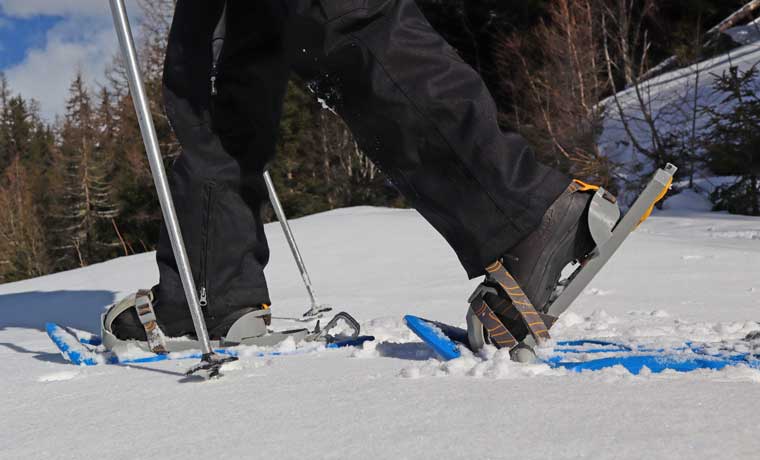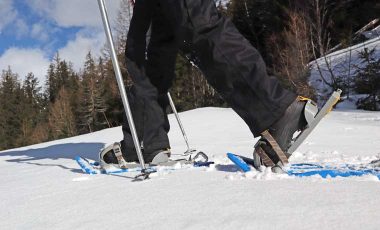Most people associate skiing and snowboarding with winter recreational sports. But not everyone has easy access to ski slopes, the resource, or indeed the desire to whizz down mountains at high speed! Snowshoeing, on the other hand, is an inexpensive way to enjoy time in the snow without investing in lots of gear and clothing. It also doesn’t require specialist knowledge and you don’t even need lessons to give it a go. Our guide to snowshoeing for beginners takes you through everything you need to know to get started and enjoy time out in the wild in snowy conditions.
What is snowshoeing?
Snowshoeing is a form of hiking and is certainly not a new activity. Variations of the snowshoes we use today have been used for thousands of years in winter climates all over the world. In fact, the world’s oldest snowshoe was found in 2016 in the Dolomites. It is dated to between 3800 and 3700 B.C.
Snowshoeing is a way of walking in deep snow without sinking into the snow with every step. It requires the use of snowshoes that are strapped onto the bottoms of winter boots. The snowshoes spread the weight of each step across a wide area on the top of the snow, enabling hikers to move forward with greater ease than if they were only wearing boots.
For more information about snowshoes, how they work, and which are best, read our guide to snowshoes.
How to start snowshoeing
Snowshoeing for beginners is easy to pick up without any tutorials or lessons. One of the best ways to start snowshoeing is to rent a pair of flat terrain snowshoes from an outfitter. They will be able to recommend a suitable trail for you to explore. But there’s a few more things to consider before you trek off into the snow with tennis racquets strapped to your feet! Read the rest of our guide to snowshoeing for beginners to make sure you’re fully prepared.
Who can go snowshoeing?
Snowshoeing is an excellent way for families to get outside and explore during the winter months. You can get snowshoes for all sizes, including kids.
Many hikers take to snowshoeing during the winter months to get their mountain fix. It’s also popular with skiers and snowboarders when the conditions on the slopes aren’t the best.
You don’t need to be super fit to go snowshoeing, either. Of course, the fitter you are the further and faster you can go. But, much like hiking, snowshoeing can be done to suit any fitness level. Just be sure to choose an appropriate length trail that provides a level of challenge that you can physically manage. Many people even go snowshoeing to improve their fitness through the winter.
Where can I go snowshoeing?
Providing you are not in an area where there is a risk of avalanches, the best places to go snowshoeing is on existing hiking trails. These might be in your local forest or park, along a river valley or in the foothills of mountain resorts. If you are at all unsure about avalanche dangers then choose a different trail recommended by a reputable mountain guide or tourist information.
If you are completely new to snowshoeing then you should definitely take advice on where to go snowshoeing from your snowshoe rental shop, a mountain guide or even go on a guided tour.
Go on a guided snowshoeing tour
If you’re unsure about whether you’ll get on OK with snowshoeing or where best to go, then it’s a good idea to take a snowshoeing tour. Your guide will provide you with snowshoes, fit them for you and explain how to walk in them. They will then take you on an appropriate trail based on your fitness levels and help you improve your snowshoeing technique as you go.
Rent or buy snowshoes and choose your own trail
If you are opting to go snowshoeing without a guide then the next best thing to do is to go with a friend who knows what they’re doing and where to do it. Renting snowshoes is ideal if you’ve never done it before as you may hate it! You may also find that you need to rent a few different types of snowshoes before you buy your own, to decide which pair suits your needs best.

What to wear snowshoeing
Layering is the key to snowshoeing in comfort. If the temperature is very low then you’ll need to pay close attention to how much you are sweating. And yes, no matter how cold it is, you’ll probably get a sweat on, especially if you are dressed for the cold! However, as soon as you stop moving, for a rest or to re-fuel, your sweat will cool on your body and can decrease your body temperature quickly.
Wearing layers, however, means that as soon as you start to sweat, you can remove a layer. Then put it back on as soon as you stop moving. If it is snowing, then you will also need to consider waterproof outer layers.
For more details about clothing options read our guide on what to wear snowshoeing.
Snowshoe clothing quick checklist:
Long johns
- Thermal base layer
- Fleece jacket or hoodie
- Waterproof or windproof jacket (or ski jacket)
- Waterproof or windproof pants (or ski pants)
- Gloves
- Hat
- Buff
- Warm socks
- Winter boots or hiking boots
- Sunglasses
What gear do I need for snowshoeing?
One of the most appealing things about snowshoeing for beginners is the lack of gear that you need. Aside from warm clothing, as mentioned above, you will need:
- Snowshoes
- Walking poles with snow baskets at the bottom
The size snowshoe you choose is dependent on your weight, plus the weight of the pack you will likely be carrying. It’s also dependent on the conditions of the snow and the terrain you will be travelling on. The place you rent your snowshoes from will recommend the appropriate snowshoe size and type.

What to pack for snowshoeing
Though the gear list for snowshoeing itself is short, there are lots of other things that you must take on a snowshoeing excursion. As with any outdoor adventure, being prepared is essential. In winter conditions this is even more important. A small accident or minor injury can quickly turn into a bigger problem in the cold, so be sure to tell someone where you are going and pack the following:
- Water – dehydration is a highly overlooked issue in the cold. So keep guzzling!
- Snacks
- Hot drink
- An extra layer – ideally something insulated like a down jacket.
- Spare gloves – incase yours get wet in the snow, or if your hands are overheating.
- Headlamp – just in case
- First aid kit
- Map and compass
- Sunscreen
- Backup phone charger – batteries die very quickly in the cold
What shall I expect from my first snowshoeing trip?
Snowshoeing enables hikers to get to remote and quiet places that folk without snow-adapted footwear can’t get to. So you should expect to feel close to nature and detached from the stresses of everyday life.
You should also expect to topple over at least once! It’s easy to forget that you have tennis racquets for feet, especially when you stop to take a photo or have a break and then start moving again. But this is all part of the fun and you’ll soon get used to not turning quickly or trying to walk backwards without thinking about it.
With this in mind, getting up from a tumble can be more tricky than you might think. In deep snow, you’ll need to use your poles to push yourself up, or even get someone else to help you.
Depending on the type of trail you snowshoe on, you should expect to get puffed out. Although snowshoeing is much easier than walking in snow in regular boots, it’s still harder than walking on the pavement! Add in an uphill or downhill section to the trail, and your heart-rate will soon get thumping.
And finally, you should expect to change your layers more than once! Again, this depends on how demanding the trail is. But taking the time to adjust your layers, or at the very least vent your jacket open, is worth the trouble to help regulate how much you are sweating.

How to snowshoe
Now for the fun stuff… how to snowshoe!
How to put on snowshoes
Most snowshoes are adjustable to fit the boots you are wearing. So before you secure them onto your feet, be sure to size them up correctly. Your snowshoe outfitter will help with this.
Once you’re all sized up, getting your snowshoes on is easy:
Place your toe into the front of the binding first.
- Then push your heel into the back of the binding.
- Once your whole foot is in place, tighten the strap over your toes and then secure the strap around your heel.

How to walk in snowshoes
Walking in snowshoes is easier than you might think. Start slow and on flat terrain and you’ll pick it up in no time. The main thing to remember is to keep your feet a little wider apart than when you walk normally. This prevents you from stepping on the inner edge of your other snowshoe.
Snowshoes are designed so that the balls of your feet are attached to the snowshoes at a pivot point when the bindings attach to the snowshoe frame. The heels are your feet are not attached to the snowshoes but come up off the snowshoe decks with each step. This enables you to walk in a relatively natural and intuitive way.
How to walk uphill in snowshoes
Many snowshoes have a heel riser bar. This is positioned underneath or behind your heel and is flush with the deck of the snowshoes when not in use. Raise up the bar and snowshoeing uphill becomes a great deal easier. The heel raiser stops your heels from lowering all the way back down to the snowshoe decks, keeping your feet in a more flat position as you ascend. The benefit of this is less strain through your calves, more weight into your toes and better grip in the snow.

Snowshoeing tips for beginners
01In very deep snow try to keep the fronts of your snowshoes on top of the snow. Do this by lifting your feet up a little higher than normal with each step.
02Use your poles! They will help to keep you balanced, drive you forwards and also take a little weight off your feet. Use snowshoeing poles in a similar way to hiking poles. For more information read our guide to using hiking poles.
03When walking downhill, be sure to lift your feet a little higher than normal to prevent your toes from clipping the snow as you bring them up. Doing this will help prevent you from toppling forwards. Placing your poles in front of you before each step will also help you stay stable as gravity pulls you forwards.
04Stop regularly to rest. Your body will be working harder than during normal hiking. When you stop, you’ll also hear all the sounds of nature. Don’t forget to notice them and enjoy them!
05Keep your eyes open for animal tracks in the snow. It’s a fun way to pass the time on a long trail and if you’re quiet enough then you may also see the the animals and birds themselves.
Where to learn more about how to snowshoe
There is a ton of information and resources online about snowshoeing. Take a look at Snowshoe Magazine to learn more about how and where to get started.
If you’re looking to join a snowshoeing group or meet fellow snowshoers then Meetup is an excellent place to start. There are also lots of Facebook groups too.
For more information on spending time outside in winter conditions, read our guide to winter hiking.



